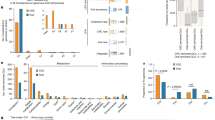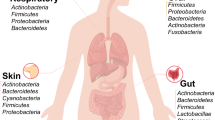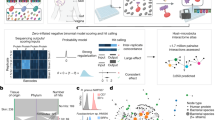Abstract
The gut microbiota affects many important host functions, including the immune response and the nervous system1. However, while substantial progress has been made in growing diverse microorganisms of the microbiota2, 23–65% of species residing in the human gut remain uncultured3,4, which is an obstacle for understanding their biological roles. A likely reason for this unculturability is the absence in artificial media of key growth factors that are provided by neighbouring bacteria in situ5,6. In the present study, we used co-culture to isolate KLE1738, which required the presence of Bacteroides fragilis to grow. Bioassay-driven purification of B. fragilis supernatant led to the isolation of the growth factor, which, surprisingly, is the major inhibitory neurotransmitter GABA (γ-aminobutyric acid). GABA was the only tested nutrient that supported the growth of KLE1738, and a genome analysis supported a GABA-dependent metabolism mechanism. Using growth of KLE1738 as an indicator, we isolated a variety of GABA-producing bacteria, and found that Bacteroides ssp. produced large quantities of GABA. Genome-based metabolic modelling of the human gut microbiota revealed multiple genera with the predicted capability to produce or consume GABA. A transcriptome analysis of human stool samples from healthy individuals showed that GABA-producing pathways are actively expressed by Bacteroides, Parabacteroides and Escherichia species. By coupling 16S ribosmal RNA sequencing with functional magentic resonance imaging in patients with major depressive disorder, a disease associated with an altered GABA-mediated response, we found that the relative abundance levels of faecal Bacteroides are negatively correlated with brain signatures associated with depression.
This is a preview of subscription content, access via your institution
Access options
Access Nature and 54 other Nature Portfolio journals
Get Nature+, our best-value online-access subscription
$29.99 / 30 days
cancel any time
Subscribe to this journal
Receive 12 digital issues and online access to articles
$119.00 per year
only $9.92 per issue
Buy this article
- Purchase on Springer Link
- Instant access to full article PDF
Prices may be subject to local taxes which are calculated during checkout



Similar content being viewed by others
Data availability
The 16S rRNA sequence and genome data for KLE1738 are available from the NCBI (MH636586 and PRJNA482656, respectively). The American Gut sequence data are available from the EBI under accession ERP012803. fMRI data are available at the discretion of M.J.D. All other data that support the findings of this study are available from the corresponding author upon request.
References
Fung, T. C., Olson, C. A. & Hsiao, E. Y. Interactions between the microbiota, immune and nervous systems in health and disease. Nat. Neurosci. 20, 145–155 (2017).
Browne, H. P. et al. Culturing of ‘unculturable’ human microbiota reveals novel taxa and extensive sporulation. Nature 533, 543–546 (2016).
Lagier, J. C. et al. The rebirth of culture in microbiology through the example of culturomics to study human gut microbiota. Clin. Microbiol. Rev. 28, 237–264 (2015).
Lagkouvardos, I., Overmann, J. & Clavel, T. Cultured microbes represent a substantial fraction of the human and mouse gut microbiota. Gut Microbes 8, 493–503 (2017).
D’Onofrio, A. et al. Siderophores from neighboring organisms promote the growth of uncultured bacteria. Chem. Biol. 17, 254–264 (2010).
Fenn, K. et al. Quinones are growth factors for the human gut microbiota. Microbiome 5, 161 (2017).
Carlier, J. P., Bedora-Faure, M., K’Ouas, G., Alauzet, C. & Mory, F. Proposal to unify Clostridium orbiscindens Winter et al. 1991 and Eubacterium plautii (Seguin 1928) Hofstad and Aasjord 1982, with description of Flavonifractor plautii gen. nov., comb. nov., and reassignment of Bacteroides capillosus to Pseudoflavonifractor capillosus gen. nov., comb. nov. Int. J. Syst. Evol. Microbiol. 60, 585–590 (2010).
Klaring, K. et al. Intestinimonas butyriciproducens gen. nov., sp. nov., a butyrate-producing bacterium from the mouse intestine. Int. J. Syst. Evol. Microbiol. 63, 4606–4612 (2013).
Yarza, P. et al. Uniting the classification of cultured and uncultured bacteria and archaea using 16S rRNA gene sequences. Nat. Rev. Microbiol. 12, 635–645 (2014).
Fodor, A. A. et al. The “most wanted” taxa from the human microbiome for whole genome sequencing. PLoS ONE 7, e41294 (2012).
Lagkouvardos, I. et al. IMNGS: a comprehensive open resource of processed 16S rRNA microbial profiles for ecology and diversity studies. Sci. Rep. 6, 33721 (2016).
Goodman, A. L. et al. Extensive personal human gut microbiota culture collections characterized and manipulated in gnotobiotic mice. Proc. Natl Acad. Sci. USA 108, 6252–6257 (2011).
Deutscher, J., Francke, C. & Postma, P. W. How phosphotransferase system-related protein phosphorylation regulates carbohydrate metabolism in bacteria. Microbiol. Mol. Biol. Rev. 70, 939–1031 (2006).
Feehily, C. & Karatzas, K. A. Role of glutamate metabolism in bacterial responses towards acid and other stresses. J. Appl. Microbiol. 114, 11–24 (2013).
Hardman, J. K. & Stadtman, T. C. Metabolism of omega-amino acids. I. Fermentation of gamma-aminobutyric acid by Clostridium aminobutyricum n. sp. J. Bacteriol. 79, 544–548 (1960).
Fallingborg, J. Intraluminal pH of the human gastrointestinal tract. Dan. Med. Bull. 46, 183–196 (1999).
Aziz, R. K. et al. The RAST Server: rapid annotations using subsystems technology. BMC Genomics 9, 75 (2008).
Bateman, A. et al. UniProt: a hub for protein information. Nucleic Acids Res. 43, D204–D212 (2015).
McDonald, D. et al. American gut: an open platform for citizen science microbiome research. mSystems 3, e00031–18 (2018).
Sneath, P. H. Principles of bacterial taxonomy. Proc. R. Soc. Med. 65, 851–852 (1972).
Arkin, A. P. et al. The United States Department of Energy Systems Biology Knowledgebase. Nat. Biotechnol. 36, 566–569 (2018).
Ni, Y., Li, J. & Panagiotou, G. A molecular-level landscape of diet–gut microbiome interactions: toward dietary interventions targeting bacterial genes. mBio 6, e01263-15 (2015).
Haas, B. J. et al. De novo transcript sequence reconstruction from RNA-seq using the Trinity platform for reference generation and analysis. Nat. Protoc. 8, 1494–1512 (2013).
Matsumoto, M. et al. Colonic absorption of low-molecular-weight metabolites influenced by the intestinal microbiome: a pilot study. PLoS ONE 12, e0169207 (2017).
van Berlo, C. L. et al. Gamma-aminobutyric acid production in small and large intestine of normal and germ-free Wistar rats. Influence of food intake and intestinal flora. Gastroenterology 93, 472–479 (1987).
Fujisaka, S. et al. Diet, genetics, and the gut microbiome drive dynamic changes in plasma metabolites. Cell Rep. 22, 3072–3086 (2018).
Luscher, B., Shen, Q. & Sahir, N. The GABAergic deficit hypothesis of major depressive disorder. Mol. Psychiatry 16, 383–406 (2011).
Davidson, R. J., Pizzagalli, D., Nitschke, J. B. & Putnam, K. Depression: perspectives from affective neuroscience. Annu. Rev. Psychol. 53, 545–574 (2002).
Greicius, M. D., Krasnow, B., Reiss, A. L. & Menon, V. Functional connectivity in the resting brain: a network analysis of the default mode hypothesis. Proc. Natl Acad. Sci. USA 100, 253–258 (2003).
Greicius, M. D. et al. Resting-state functional connectivity in major depression: abnormally increased contributions from subgenual cingulate cortex and thalamus. Biol. Psychiatry 62, 429–437 (2007).
Sheline, Y. I. et al. The default mode network and self-referential processes in depression. Proc. Natl Acad. Sci. USA 106, 1942–1947 (2009).
Liston, C. et al. Default mode network mechanisms of transcranial magnetic stimulation in depression. Biol. Psychiatry 76, 517–526 (2014).
Koechlin, E. & Hyafil, A. Anterior prefrontal function and the limits of human decision-making. Science 318, 594–598 (2007).
Wager, T. D., Davidson, M. L., Hughes, B. L., Lindquist, M. A. & Ochsner, K. N. Prefrontal–subcortical pathways mediating successful emotion regulation. Neuron 59, 1037–1050 (2008).
Tillisch, K. et al. Brain structure and response to emotional stimuli as related to gut microbial profiles in healthy women. Psychosom. Med. 79, 905–913 (2017).
Hassan, A. M. et al. High-fat diet induces depression-like behaviour in mice associated with changes in microbiome, neuropeptide Y, and brain metabolome. Nutr. Neurosci. https://doi.org/10.1080/1028415X.2018.1465713 (2018).
Bravo, J. A. et al. Ingestion of Lactobacillus strain regulates emotional behavior and central GABA receptor expression in a mouse via the vagus nerve. Proc. Natl Acad. Sci. USA 108, 16050–16055 (2011).
Janik, R. et al. Magnetic resonance spectroscopy reveals oral Lactobacillus promotion of increases in brain GABA, N-acetyl aspartate and glutamate. Neuroimage 125, 988–995 (2016).
Lin, Q. Submerged fermentation of Lactobacillus rhamnosus YS9 for gamma-aminobutyric acid (GABA) production. Braz. J. Microbiol. 44, 183–187 (2013).
Barrett, E., Ross, R. P., O’Toole, P. W., Fitzgerald, G. F. & Stanton, C. Gamma-aminobutyric acid production by culturable bacteria from the human intestine. J. Appl. Microbiol. 113, 411–417 (2012).
Pokusaeva, K. et al. GABA-producing Bifidobacterium dentium modulates visceral sensitivity in the intestine. Neurogastroenterol. Motil. 29, e12904 (2017).
Kootte, R. S. et al. Improvement of insulin sensitivity after lean donor feces in metabolic syndrome is driven by baseline intestinal microbiota composition. Cell. Metab. 26, 611–619 (2017).
Stamatakis, A. RAxML version 8: a tool for phylogenetic analysis and post-analysis of large phylogenies. Bioinformatics 30, 1312–1313 (2014).
Wattam, A. R. et al. Improvements to PATRIC, the all-bacterial Bioinformatics Database and Analysis Resource Center. Nucleic Acids Res. 45, D535–D542 (2017).
Wixon, J. & Kell, D. The Kyoto encyclopedia of genes and genomes—KEGG. Yeast 17, 48–55 (2000).
Kitagawa, M. et al. Complete set of ORF clones of Escherichia coli ASKA library (a complete set of E. coli K-12 ORF archive): unique resources for biological research. DNA Res. 12, 291–299 (2005).
Hyatt, D. et al. Prodigal: prokaryotic gene recognition and translation initiation site identification. BMC Bioinformatics 11, 119 (2010).
Caporaso, J. G. et al. QIIME allows analysis of high-throughput community sequencing data. Nat. Methods 7, 335–336 (2010).
Amir, A. et al. Deblur rapidly resolves single-nucleotide community sequence patterns. mSystems 2, e00191–16 (2017).
Amir, A. et al. Correcting for microbial blooms in faecal samples during room-temperature shipping. mSystems 2, e00199–16 (2017).
Chang, C. & Glover, G. H. Effects of model-based physiological noise correction on default mode network anti-correlations and correlations. Neuroimage 47, 1448–1459 (2009).
Shirer, W. R., Ryali, S., Rykhlevskaia, E., Menon, V. & Greicius, M. D. Decoding subject-driven cognitive states with whole-brain connectivity patterns. Cereb. Cortex 22, 158–165 (2012).
Acknowledgements
The authors would like to thank S. Rubin for help with the cultivation of KLE1738, and J. Wang of the Small Molecule Mass Spectrometry Facility, a Harvard Faculty of Arts and Science (FAS) Division of Science Core Facility, for analysing the GC/MS samples. This work was supported by grants R01HG005824 to K.L., R01GM086158 to J.C. and F32GM108415 to T.R.R.
Author information
Authors and Affiliations
Contributions
P.S. and K.L. planned the study, analysed the data and wrote the paper. P.S. performed the co-culture screening for helper-dependent pairs and general KLE1738 cultivation. P.S., J.C. and K.H.K. designed and performed the bioassay-driven screening for GABA. P.S. and N.M. performed media exclusion experiments. P.S., E.J.S. and D.D. analysed the KLE1738 genome. P.S., D.D. and T.R.R. performed 13C feeding experiments. P.S. cultivated B. fragilis and D.D. analysed the supernatant for GABA and glutamate. P.S. designed and with A.L. executed the screen for GABA-producing bacteria. P.S. prepared the supernatant of GABA producers identified in the KLE1738 co-culture screen, and D.D. analysed these supernatants for GABA production. P.S., D.M., R.K., J.L., J.K.L. and K.Z. performed the metagenomic analysis for GABA producers and consumers, and P.S., A.S., and J.A.G. analysed the human transcriptome dataset. P.S., K.L., D.T. and M.J.D. designed the MDD study, and P.S., K.L., A.S., J.A.G., D.T., C.L. and M.J.D. analysed the MDD data. All authors helped edit the manuscript.
Corresponding authors
Ethics declarations
Competing interests
P.S. and K.L. declare competing financial interests as they are founders of Holobiome, Inc. All other authors have no competing interests.
Additional information
Publisher’s note: Springer Nature remains neutral with regard to jurisdictional claims in published maps and institutional affiliations.
Supplementary information
Supplementary Information
Supplementary Figures 1–8, Supplementary Tables 1–4 and 6–8.
Supplementary Table 5
Genome analysis of GABA modulating potential of 1,159 gut bacterial genomes, consisting of 919 species.
Rights and permissions
About this article
Cite this article
Strandwitz, P., Kim, K.H., Terekhova, D. et al. GABA-modulating bacteria of the human gut microbiota. Nat Microbiol 4, 396–403 (2019). https://doi.org/10.1038/s41564-018-0307-3
Received:
Accepted:
Published:
Issue Date:
DOI: https://doi.org/10.1038/s41564-018-0307-3
This article is cited by
-
Bridging the gap: associations between gut microbiota and psychiatric disorders
Middle East Current Psychiatry (2024)
-
Longitudinal multi-omics analysis uncovers the altered landscape of gut microbiota and plasma metabolome in response to high altitude
Microbiome (2024)
-
Systematic identification of the role of gut microbiota in mental disorders: a TwinsUK cohort study
Scientific Reports (2024)
-
Microbiota–gut–brain axis and its therapeutic applications in neurodegenerative diseases
Signal Transduction and Targeted Therapy (2024)
-
Gamma-aminobutyric acid as a potential postbiotic mediator in the gut–brain axis
npj Science of Food (2024)



